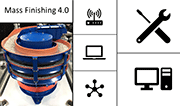E-Archive
Good Vibrations
in Vol. 19 - November Issue - Year 2018
What if… - Finishing 4.0

What would happen if it were possible to transfer the principles of today's digitization to the world of mass finishing equipment? At first sight, totally unthinkable, unimaginable. At second sight, still totally unthinkable and perhaps not totally unimaginable? Let us try it…
We can observe a trend away from hardware. Especially in electronic branches where complete hardware modules are replaced by software solutions. One example is ISDN relay modules, which were once produced by Siemens. Today, these hardware products are not in existence, as software is doing their job. There are numerous other examples of a shift of functionality away from hardware into software.
It is totally obvious that this will never ever happen to the branch of mechanical engineering and to mass finishing equipment. How can a machine with some smart functions ever be replaced by software? Never.
But might there be trends of changing machines, or trends of changing the business model in the area of mechanical engineering? Well, maybe. A German manufacturer of rolling machines is an early adopter of not selling hardware, but sharing hardware. Like car-sharing businesses or Airbnb, they are not only selling their machines. They are selling running time with guaranteed availability, because they have standardized their products to an advanced degree. They are also able to deliver such a quality, that they organize their service and maintenance of the rolls around that "running-time-model". Every machine which is not sold but operates in "running-time-mode" is controllable via remote access. Furthermore, the components can themselves actively connect to their manufacturer and are actively transferring active status information. Not only errors logged by the PLC, but anomalies observed by sensors are also sent to the producer’s mission control center.
There, this information is used to produce forecasts for the failure probability of certain components. As a consequence, the service resources can easily be planned and sent to the operator in a timely manner. In return, the operator has a clearly reduced risk of production downtimes. What a wonderful win-win-situation, if the price for running time is attractive enough!
And to calculate an attractive price, standardization and running-time quality is a necessary requirement. That fact seems to finally shatter the idea of transferring any kind of digitization model to the mostly specialized world of mass-finishing equipment. Drums in any possible shape, vibrators in different modifications and finally centrifugal finishers with customized loading and unloading functionality in production lot size 1 are far away from standardization. Machines are adapted for different branches; the most ultimate finisher is the most work-piece-adapted finisher.
In the nineteen-nineties (1990s), there was a small German finishing startup. They did not care about different types of machines. They asked themselves simply what would be the most effective kind of finishing for mass goods and decided to build only centrifugal finishers. Today, that company is a leading manufacturer of small centrifugal finishers.
Now let us think about another startup, Scifinish Ltd. They decided to build the one-in-all finisher, the ultimate finisher which combines centrifugal and vibratory forces in one concept. Surely a couple of engineers might have tested the concept of one bowl for both in earlier decades - but they all failed. Today, however, the actual technology offers better equipment and so they built a prototype of Scifinish 1, a working bowl that is able to vibrate and produce centrifugal force with only one driving unit.
Their engineers reinvented the translation of force, so that the same motor unit could generate vibration with unbalanced weights as well as rotational force for the lower part of the bowl.
Additionally, the center cathedral of the treatment bowl could be extended to a certain height for the vibratory mode in order to produce a circulating behavior, as in conventional round-tub vibrators.
The Scifinish Centrifugal Vibrator was delivered in only three sizes and could be used for an immense spectrum of parts. The machine was able to generate a finishing force in any required strength and quality and could be switched instantly from vibratory to centrifugal mode. A new finishing mode was delivered by software update.
Furthermore it contained an integrated separation screen like a classic round-tub vibrator, which could be moved into the surface of the mass in order to skim out the workpieces, so it became cheaper than standard centrifugal finishers, and now it has become really ridiculous.
But if we take such a concept for granted and if such a one-for-all finisher existed, then a business model of selling running-time instead of hardware would not be so far away any more for the mass-finishing world. Perhaps we have to wait until another Thomas Edison to reinvent the way we finish and say "I have not failed. I’ve just found 10.000 ways that won’t work!"
Good Vibrations
by Mathieu Geuting
Spaleck Oberflächentechnik GmbH & Co. KG, Germany
Tel. +49.2871.9500 14
Fax +49.2871.9500 95
E-mail: m.geuting@spaleck.biz



























